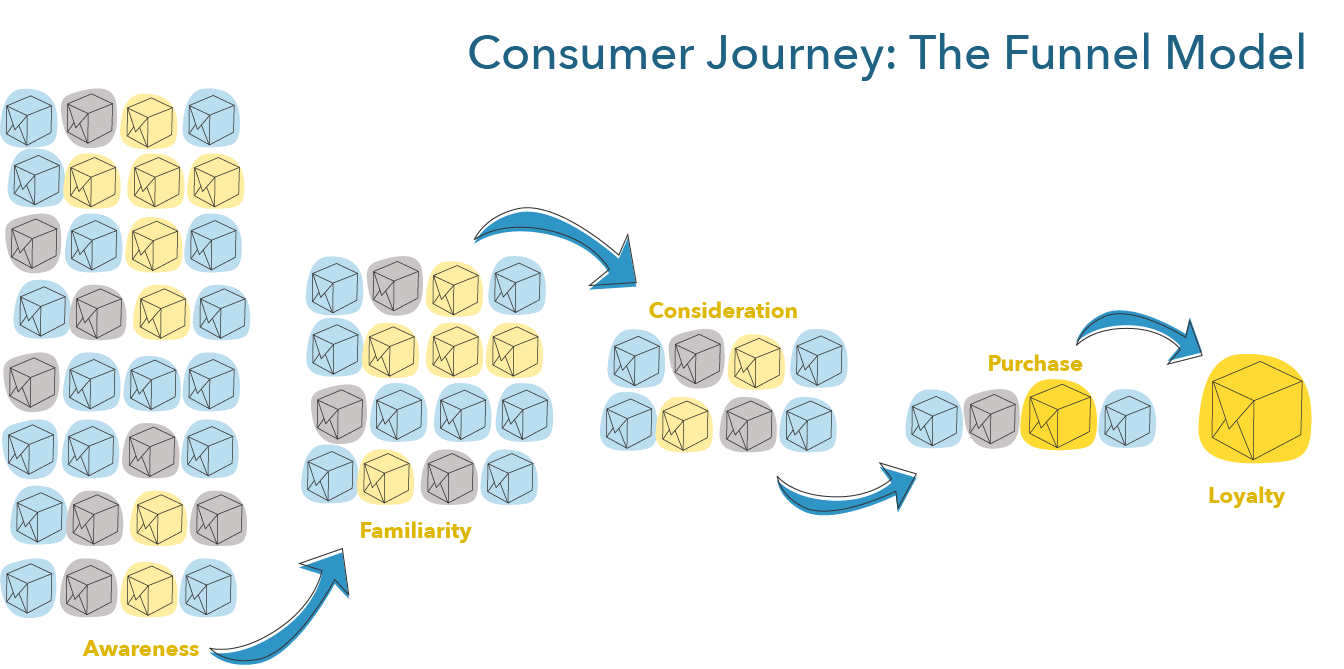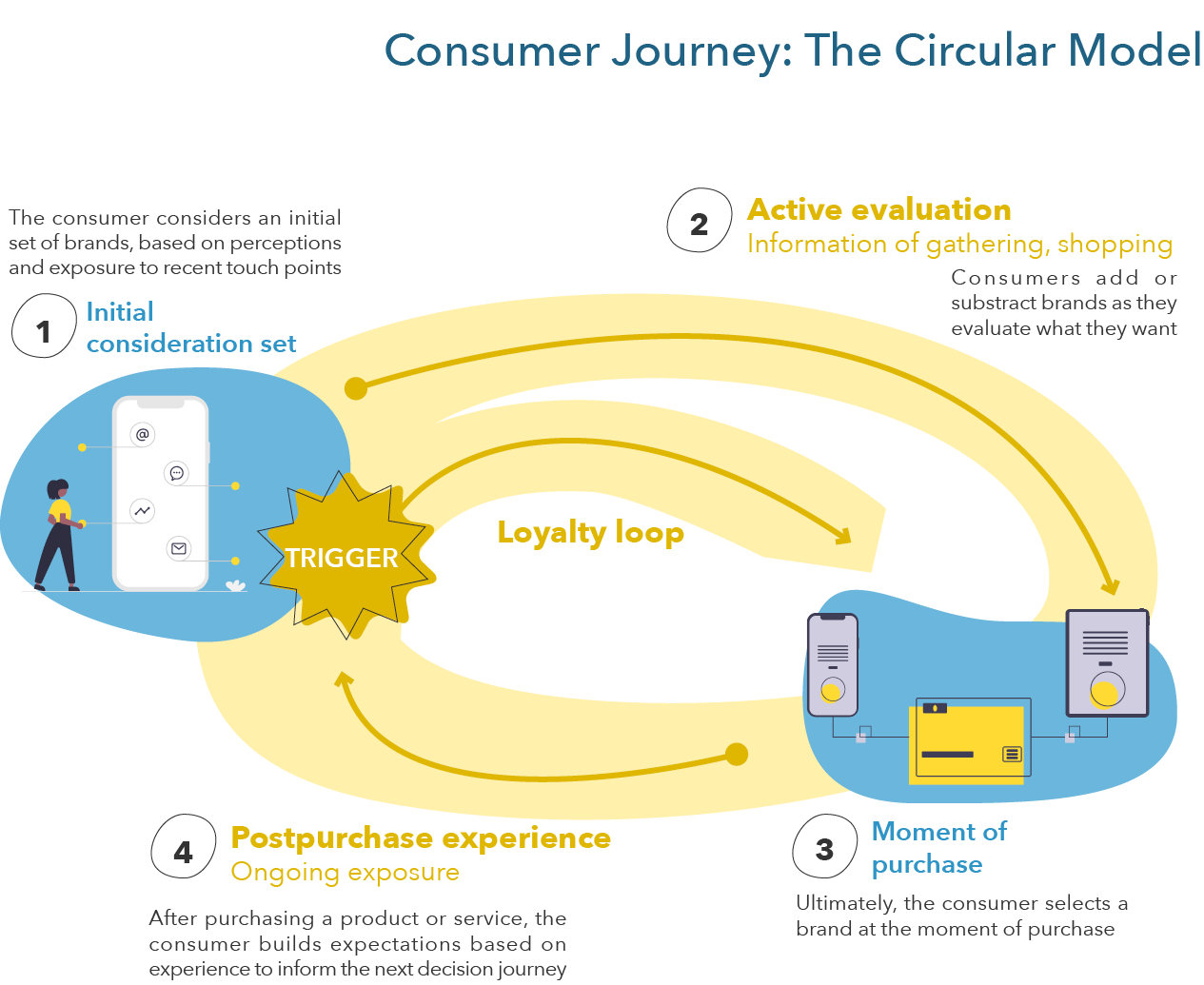Understanding Consumer Journeys
Our understanding of consumer journeys has greatly evolved over the last two decades, and there exist a number of ways to conceptualize journeys. It is important to understand that these are not perfect representations of reality. Rather, they are thinking tools that help us create marketing campaigns. In real life, people tend not to be so linear in their decisions.
A common conceptualization found in marketing textbooks is one where consumers move between different stages, initially being aware of a large number of brands and then slowly refining their understanding of the options in the market to make their purchase. McKinsey represents such a typical model here (Figure 2.4). In this model, the consumer goes through five stages:
- Awareness: the consumer is aware of a large number of products or brands in the market that might help address their need.
- Familiarity: From this large number of brands or products they are aware of, the consumer will perform some initial research and become familiar with a subset of brands.
- Consideration: From this smaller number of familiar brands, the consumer will continue their research efforts, eliminate some brands that do not fit their criteria, and narrow their list to a smaller number of considered brands (i.e., a “consideration set”).
- Purchase: Once ready to buy, the consumer might try out a product or seek in-depth information on an even smaller subset based on their consideration set, from which they will purchase a product or choose a brand.
- Loyalty: Assuming their consumption experience goes well, the consumer may become loyal to the product or the brand.
Figure 2.4 Consumer Journey: The Funnel Model

This understanding of the journey is based on a funnel model, where consumers start by being aware of a large number of brands and, over time, reduce their options as they go through each of the stages. This has a number of implications for marketers.
A first central assumption is that, to ultimately be chosen by consumers, companies need to make sure that consumers are aware of them. This partly helps explain the prevalence of mass marketing: it serves to create awareness.
A second central assumption is that consumers start with a large set of brands that they are aware of and reduce this set over time to a smaller and smaller set of brands as they search for and evaluate options.
McKinsey introduced in 2009 a competing model for the consumer journey, based on the purchase decisions of close to 20,000 consumers across five industries. They found that these two assumptions did not hold: First, consumers do not start with a large set of brands they are aware of. Second, consumers do not reduce their options as they go through the stages of the funnel. Rather, the number of options they consider increases throughout their journey.
If you think of some recent purchases you made, this makes sense. Let’s say I want a pair of running shoes. I might be aware of some brands and models, probably the ones that do the most mass advertising: Nike, Adidas, Reebok. Then, I turn to the internet to perform some searches. I’ll use general key terms like “what running shoes should a beginner get” or “reviews for running shoes 2020.” Through my search efforts, I will encounter new brands I had not considered originally, for example, Asics, Brooks, and Saucony.
In this example, rather than following the funnel metaphor, where the set of brands I was aware of reduced to a smaller set of familiar brands and an even smaller set of considered brands, I added brands to my consideration set.
This has important implications for digital marketers: First, traditional, push, mass marketing media activities are not necessary. Second, as consumers do research, they broaden the set of products or brands they consider. We will see how this has led to the rapid growth of inbound marketing activities that help consumers with their problems and help consumers evaluate their options. This is because brands now understand that by supporting consumers throughout their journey, they can enter consumers’ consideration set and ultimately make a sale.
McKinsey thus proposes a competing model, a circular model for the consumer journey. The model is circular because consumers enter a loyalty loop where they cycle between using a product or brand, buying this product or brand again, participating in post-purchase activities, and so on. The McKinsey model has the following stages (also depicted in Figure 2.5):
Figure 2.5 Consumer Journey: The Circular Model

- Trigger: The consumer experiences a need, a problem, or wants to achieve a goal, which initiates their journey
- Initial consideration set: The consumer considers an initial set of brands based on their experiences, brand perceptions, and exposure to recent touchpoints. For the initial consideration set, the most influential touchpoint is company-driven marketing, such as advertising, direct marketing, sponsorship, and the like. See a graphic representation here.
- Active evaluation: This is a new stage introduced by McKinsey. At this stage, the consumer actively evaluates their options through information gathering and shopping. Often, consumers will do their information gathering online. It is at this stage that consumers add brands to their consideration set. We are not in a funnel model anymore. This is the first difference important to digital marketers: It means we can enter consumers’ consideration set without having to conduct awareness-generating campaigns. If we help consumers make their decisions, or if we have reviews online, for example, we can be considered by them. McKinsey finds that the most influential touchpoint for this stage is consumer-driven marketing, such as word of mouth, the information found during online searches, and reviews.
- Moment of purchase: The consumer selects a brand and make a purchase.
- Post-purchase experience: After purchasing a product or a service, the consumer builds expectations based on their experience. This will inform the loyalty loop. A second important difference from the funnel journey happens at this stage: Consumers start creating content for brands (i.e., the “consumer-driven marketing” efforts I refer to in stage ‘3’). Think about products or services you bought recently: Maybe you posted a picture about it on Instagram, maybe you wrote a review on Yelp!, or maybe you participated in some company-supported marketing activities.
These two important revisions to the journey—the expansion of the consideration set during active evaluation and the importance of consumers participating in consumer-driven marketing at the post-purchase stage—open up many content-based possibilities for digital marketers. As we’ve discussed, our goal in digital marketing is to represent the customer: What are their needs? Goals? Problems? How can we support them in addressing these? Our objectives are not to sell products or talk about our brand. Rather, we will see that we make sales online by supporting consumers throughout their journey—helping them understand their problem, helping them evaluate solutions, helping them better understand our product.
